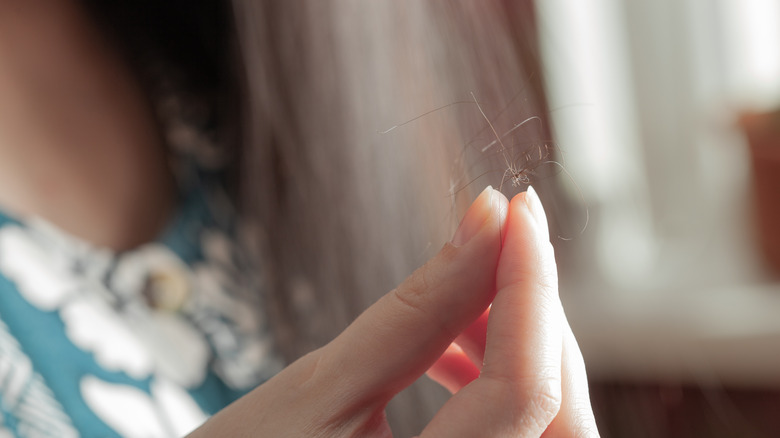What's Causing Those White Dots On The End Of Your Hair
If you've ever pulled a stray hair off the back of your shirt, you might be surprised to find a small, white dot seated at the end of the strand. You've ruled out dandruff, so what could it be?
First, a little background. It is not unusual for the average person to shed as many as 100 hairs daily, according to the Cleveland Clinic. As our hair grows, it goes through both active and dormant phases. The first phase of this cycle is the anagen phase (via StatPearls). As a years-long process, it's during this phase that the hair follicle takes its bulbous form and begins producing the hair fiber. Next is the catagen phase, in which the hair progressively transitions into dormancy over the course of several weeks and shrinks in diameter.
Finally, hair enters the telogen phase. In this resting phase, growth ceases and the hair follicle may remain inactive for as long as one year atop our head. When it comes to those white dots on the end of our hair, the hair root is likely what you're seeing (via Hers).
What is telogen effluvium?
The shedding of stray hairs with a white bulb in tow is not abnormal. However, if it's happening on a fairly regular basis, you may potentially be dealing with telogen effluvium, reports Hers. Usually brought on by stress, those with the condition may shed as many as 300 strands of hair on a daily basis (per Cleveland Clinic). Usually affecting the top of the head, acute telogen effluvium often resolves on its own within three to six months. Cases of chronic telogen effluvium are those that extend beyond six months.
Telogen effluvium is among the top causes of accelerated hair loss, but there are ways in which it can be managed and prevented. Keeping your stress levels in check is paramount. This can include getting adequate sleep, plenty of exercise, and eating a healthy diet rich in protein and green leafy vegetables, both of which can support the health of our hair. Hair-growth-promoting medications or supplements may also be effective. Above all, however, addressing what's causing you stress in the first place is the best way to go about managing telogen effluvium, rather than solely treating the hair loss itself.
You may have split ends
In some cases, that white dot at the end of your hair may not be the hair root at all, but something else entirely. Rather, it may be a sign of split ends, according to experts at StyleCraze. Otherwise known as a "whitened split," these white dots develop at the end of the hair shaft as a result of hair damage from harsh chemical treatments. A whitened split indicates that the hair has been fractured.
Although the only way to rid your hair of split ends is to schedule a haircut, there are ways you can help prevent future damage from occurring. For example, keep brushing and heat-based styling treatments to a minimum. Using a silk pillowcase can also help reduce hair breakage, as cotton pillowcases tend to rub more harshly against hair (via Healthline). More than anything, however, remember to moisturize. Applying a hair mask on a weekly basis can help quench your hair's thirst. Whether your hair mask is store-bought or DIY, ingredients such as coconut oil, honey, banana, olive oil, and more can help you maintain healthy, hydrated hair.



